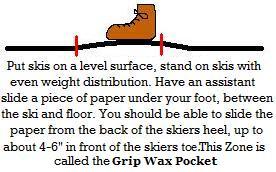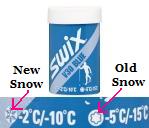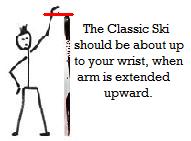Skiing Frequently Asked Questions
The world of skiing can seem intimidating, with all the waxes, different techniques and funny looking clothing. We've put together a list of questions that we hear on a regular basis, and some advice we hope that will simplify this sport and add to the enjoyment.
How do I know if my Classic skis are appropriate for me?
Over the years ski technology has slowly been changing, nothing earth shatteringly new, but the way we size skis is changing. Skis are measured 2 ways, first and most importantly we measure skis for their Camber, next, we verify that the ski is proportional to the skiers height. Camber is the stiffness of the ski. If you were to put your ski on level ground you would notice that the ski 'bows' upward, the binding is mounted on top of the arc, and your Grip Wax Pocket underneath. The amount of force it take to compress the ski to the ground refers to how stiff the Camber is. The Camber of the ski needs to be stiff enough that the Grip Wax Pocket doesn't drag the ground when you glide, but yet soft enough that your Grip Wax Pocket contacts the ground when you shift your weight and kick off. At Bikes and Beyond we have a machine to accurately test ski camber, or you can test your skis at home using the method below. Camber testing is a service that we at Bikes and Beyond offer for free!
To check your own skis for camber, start by cleaning the grip wax off the bases, set both skis on a clean, level, and sturdy surface. Next, stand on both skis with your weight evenly distributed, this simulates the glide phase of the ski technique, ideally, when you are gliding your Grip Wax Pocket should be slightly raised off the ground. With assistance of a helper, a piece of paper should fit under skiers foot between the ski and ground, and be able to slide from the back of the heal to 4-6" in front of the toe. To fine tune your Grip Wax Pocket you could mark you forward part of the Wax Pocket where the paper stops sliding. *Note: The Grip Wax Pocket DOES NOT extend past the skiers heel.
 |
This is an approximate measurement |
How do I wax my skis?
Does it seem difficult to get your skis to propel forward? Can't find grip for climbing hills? Do your skis feel slow? These types of problems can be a result of poor waxing, poor wax choice or a ski that is not appropriate for the skiers weight or technique. We will deal with waxing here, if proper waxing doesn't help, see 'How do I know if my classic skis are appropriate for me?'
 |
The Grip Wax Pocket will be unique to every ski and skier. All depending on ski length/stiffness, and skier weight. |
The Classic Ski is divided into 3 parts, the Tip, Grip Wax Pocket, and the Tail. Both the Tip and the Tail benefit from Glide Wax, a wax that helps repel the snow, and makes the ski significantly quicker. But its the Grip Wax in the middle of the ski, that will help propel you forward.
Glide Wax is typically applied by melting solid wax on to the base of the ski (tips and tails only) using a waxing iron, then spread evenly. The heat from the iron opens pores in the ski and the wax is absorbed. If the wax is smoking, the heat is too high, this can melt the base of the ski, more importantly this is not good for your health. When the wax is uniformly spread on the base, you need to let the bases cool. Once cool, hold an acrylic scraper at 45o angle and evenly draw the scraper from tip of the ski toward the back of the ski. Only light pressure with the scraper is needed, to make your skis faster you can remove as much excess wax as possible, using nylon brush or fibertex pads will buff the base nicely. Glide Wax is temperature specific and available for all temperatures, these tend to give the best performance. Universal Wax which covers a wide temperature range is also available, which is still better than not waxing. It is important to keep your skis waxed, as the bases will oxidize and not accept wax if the skis are dry for too long. For the end of the season you will also want to put a layer of Storage Wax on the bases. Storage Wax is just a cheap Universal Wax that is applied, but not scraped off, this is to prevent the oxidization of the ski. If your skis are slow even after waxing, you may want to 'open the base' by lightly roughening the base with some 100 grit sandpaper, use of a sanding block is suggested. When ever you are reapplying glide wax, there is no need to try to remove any old wax... the more glide wax your ski holds, the quicker you will slide! Glide Wax will usually last for about 50 to 70kms, this will change depending on ski conditions and skiing style, if you notice your base is looking a little white-ish or chalky this is a prime indication of dry bases in need of wax.
Grip Wax is the more crucial to your skiing enjoyment. The waxes tend to be very temperature specific and cover a narrow temperature range. With grip waxing, if you don't quite have the right wax applied, it could be the most frustrating ski of your life. The first step to grip waxing is to find out how big your wax pocket is, please see 'How do I know if my classic skis are appropriate for me?" Next, all old Grip Wax needs to be removed. This can be accomplished with use of a sharp scraper, or for stubborn sticky wax, Wax Remover is suggested. If a scraper is used take caution not to gouge the base. Sandpaper can be used to roughen the base, or buff out small scratches. Once you are left with a clean slate, apply a Grip Wax Base Binder to your Grip Wax Pocket. There are Base Binder waxes, or a Polar Wax (Grip Wax for cold temperatures) will do the job just fine. This wax should also be ironed in if at all possible. This wax will assist other waxes adhere to the base, as well as give you better grip for longer distances. After the Base Binder is melted in, rub the Grip Wax Pocket with a Cork to evenly distribute the Binder. Now you are ready for your wax of the day! Check with the local weather, then inspect your waxes! written on your Grip Waxes there will be two temperature ranges, one for fresh (just fallen) snow, one for transformed snow (old, crusty and icy snow). Once you have picked your wax of the day, you 'crayon' your wax in you Grip Wax Pocket, then you heat and spread the Grip Wax by rubbing your cork over your Grip Wax Pocket.
 |
One layer of Grip Wax will last about 4-5kms, once you have corked in your Grip Wax, you can add more layers to suit how far you want to ski. If there seems to be a build up of ice and snow on your Grip Wax Pocket, your wax may be too warm. If you are lacking in grip, your wax may be too cold. Waxing is definitely a learned art! |
If you have a Waxless ski, then your Grip Wax Pocket will have a textured surface- looking almost like fish scales. Waxless skis do not require Grip Wax, but still would benefit from Glide Wax.
For a more detailed look at waxing, check out the Swix Wax School
How do I know when my skis need to be waxed?
As we saw in 'How do I wax my skis' there are 2 different types of waxes that go on the base of the ski, Glide Wax on the Tips and Tails, and Grip Wax in the Grip Wax Pocket.
With the Glide Waxes, as soon as you notice that its taking more energy to propel you forward, its time to wax. If you notice your bases look white-ish or chalky, this will be a visual indication that your bases are getting dry and could use waxing.
With the Grip Waxes, when you loose your grip or your kick, its time to reapply. It is advisable to carry your wax of the day and a cork with you when ever you ski longer distances. Applying wax when its cold can be a chore, so keep your wax close to your body. Swapping your skis from left to right can also extend your grip and traction.
What difference between Waxable and Waxless Skis?
Very simple differences between the two. With the Waxless ski, you will have a textured surface almost looking like fish scales underneath and forwards of the binding. Where on the Waxable ski, the base will be smooth the length of the ski. The Waxable ski requires wax if you plan to go anywhere. In Manitoba there is an overwhelming amount of Waxable skis on the market, for our climate and temperatures (dry and cold) this is the only ski that works consistently well. On more coastal regions, the opposite is true, when the weather is warmer and the humidity is higher, the waxless skis work great.
How do I know if my poles are the right length?
Unfortunately there isn't one right answer for that question. A lot has to do with personal preference, so all we can really do is help by giving a starting point. Most people like poles that will come up to between their armpit and shoulder. If the skiers pole is too long, they could experience tennis elbow type pain. There is also a simple formula to follow to get a ball park pole length: skier height in cm's x 0.85 = Pole Length in cm's
Where can I ski in Manitoba and Ontario?
The Cross Country Ski Association is a great resource for locations to ski as well as their ski conditions.

